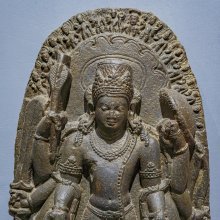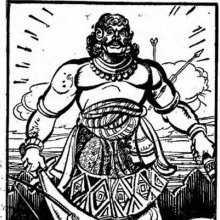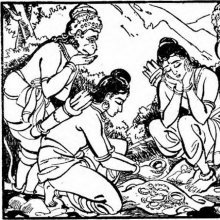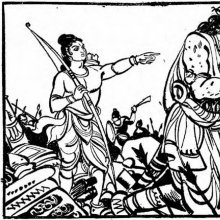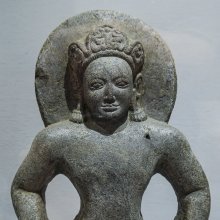Powerful: 1 definition
Introduction:
Powerful means something in Hinduism, Sanskrit. If you want to know the exact meaning, history, etymology or English translation of this term then check out the descriptions on this page. Add your comment or reference to a book if you want to contribute to this summary article.
Images (photo gallery)
(+15 more images available)
In Hinduism
Shilpashastra (iconography)
Source: Shodhganga: Elements of Art and Architecture in the Trtiyakhanda of the Visnudharmottarapurana (shilpa)Powerful looks are associated with Soldiers or Warriors, which follows specific guidelines in the tradition of ancient Indian Painting (citra), according to the Viṣṇudharmottarapurāṇa, an ancient Sanskrit text which (being encyclopedic in nature) deals with a variety of cultural topics such as arts, architecture, music, grammar and astronomy.—The pictures of warriors should express the feeling of heroism. That is why the face of a soldier is instructed as to be painted with frowns and the face should have powerful and arrogant look. Thus the Viṣṇudharmottarapurāṇa establishes the fact that even in the pictures; the people belonging to different class and profession [e.g., warriors with powerful looks] were projected with specific attire so that general people can equate the picture with the practical character.

Shilpashastra (शिल्पशास्त्र, śilpaśāstra) represents the ancient Indian science (shastra) of creative arts (shilpa) such as sculpture, iconography and painting. Closely related to Vastushastra (architecture), they often share the same literature.
See also (Relevant definitions)
Starts with: Powerful weapon.
Full-text (+2405): Balishtha, Prabala, Sashakta, Shaktimat, Sodhri, Urjita, Balavat, Samartha, Sattvasara, Atibala, Shabala, Mahodara, Galebaja, Tuvijata, Parakrami, Shavasana, Sahasvant, Dripra, Sumahabala, Prabhushnu.
Relevant text
Search found 388 books and stories containing Powerful; (plurals include: Powerfuls). You can also click to the full overview containing English textual excerpts. Below are direct links for the most relevant articles:
A Manual of Khshnoom (by Phiroz Nasarvanji Tavaria)
Harivamsha Purana (by Manmatha Nath Dutt)
Chapter 34 - Jarasandha Prepares to Attack Mathura < [Book 2 - Vishnu Parva]
Chapter 60 - An Account of Rukshmi: Krishna Takes Away Rukshmini < [Book 2 - Vishnu Parva]
Chapter 40 - The Beginning of the Dwarf Incarnation: Bali Becomes King < [Book 3 - Bhavishya Parva]
Garga Samhita (English) (by Danavir Goswami)
Verse 1.7.2 < [Chapter 7 - Description of the Conquest of All Directions]
Verse 4.21.11 < [Chapter 21 - Lord Krsna Extinguishes the Forest Fire and Reveals Himself to the Brāhmana’s Wives]
Verse 6.1.15 < [Chapter 1 - Jarāsandha’s Defeat]
The Padma Purana (by N.A. Deshpande)
Chapter 237 - The Boar Incarnation of Viṣṇu < [Section 6 - Uttara-Khaṇḍa (Concluding Section)]
Chapter 64 - Rāma’s Army Revives < [Section 5 - Pātāla-Khaṇḍa (Section on the Nether World)]
Chapter 75 - The Hymn of Victory at the End of War between Gods and Demons < [Section 1 - Sṛṣṭi-khaṇḍa (section on creation)]
Shrimad Bhagavad-gita (by Narayana Gosvami)
Verse 6.34 < [Chapter 6 - Dhyāna-yoga (Yoga through the Path of Meditation)]
Verse 3.42 < [Chapter 3 - Karma-yoga (Yoga through the Path of Action)]
Verse 16.14 < [Chapter 16 - Daivāsura-sampada-yoga]
Trishashti Shalaka Purusha Caritra (by Helen M. Johnson)
Part 17: Story of Aśvagrīva < [Chapter I - Śreyāṃsanāthacaritra]
Part 3: Previous births of Datta < [Chapter V - Dattanandanaprahlādacaritra]
Part 8: Conquest of the southern district of the Sindhu by Sagara < [Chapter IV - Conquest of Bharatavarṣa by Sagara]
Related products
(+40 more products available)
